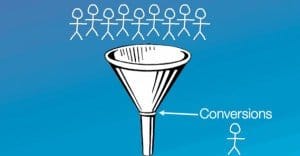How to Get Website Traffic that Converts to Sales

In one sense, getting more converting customers is all about one thing; more traffic. If your website converts at a 1% rate, pulling in 100 customers gets you one sale. Want to increase your sales? Pull in 1,000 customers instead. Want even more? Pull in 10,000 people. The more volume you have, the more your website will convert.
The problem is, this isn’t a sustainable business model. You can increase your volume to a certain point, but beyond that point your diminishing returns make it infinitely harder to keep up your growth. Instead, you need to figure out a way to increase that conversion percentage. The way you do this is through targeting your traffic growth. Rather than pulling in 1,000 people at that same 1% conversion rate, pull in 500 people at a 5% conversion rate.
Of course, the best option is to do both. If 1,000 people at 1% is good, and 500 people at 5% is better, 10,000 people at 15% is amazing. Thankfully, with good targeting and a slippery sales funnel, you can snowball up both of those numbers.
Target Forums and Communities
Every industry has a community surrounding it, people who are passionate about it, people who make careers out of it, people who are merely hobbyists. These people like to gather and discuss their passion, and so those people turn to the Internet. Web-based communities have always been one of the major strengths of the Internet, and you can take advantage of them.
Your first step is to identify those communities. There will be some big ones, like Facebook groups, LinkedIn groups, Twitter hashtags and Reddit subreddits. There may also be large, popular web forums, like Stack Overflow for programming or Bodybuilding.com for bodybuilding. You might be surprised at the communities that exist.
You need to make sure the communities you’re targeting are active and not just full of spam. Take a look, registering a dummy account if you need to, to see whether the most recent posts are legitimate or spam. If they’re legitimate, make sure they’re recent, and that there’s a reasonable volume of traffic. Nothing is quite so desperate as trying to advertise on a forum with three semi-active users.
Of course, if no such community exists, you may be able to start it yourself. It’s easy to set up a web forum, though it takes some time and energy to moderate if you don’t have a team in place. You would then gain the benefit of a forum directly tied to your brand, though making it unbranded may attract more users.
Of course, you need to avoid being banned on these forums. That means, typically, following their rules against direct advertising. You may be limited to a link in your profile or signature, or to in-context links you add during a discussion. Never dive in and start a self-promotional thread unless you want to be ostracized.
Targeted Blogging
Blogging is a multi-faceted way to create more targeted traffic. It helps you in a number of ways. First and foremost, every blog post you create is an opportunity. Every post you create is a chance to rank in organic search for a given query. Every post you create is a possible landing page for a link from some community, blog, social network or news agency. Every post you create is another potential conversation for which your content will be relevant.
The point is that you should be blogging as much as possible, as often as possible, about as wide a range of interrelated subjects as possible. If your focus is too narrow, your blog posts start to crowd each other and you encounter keyword cannibalization. If your focus is too broad, you’re encountering that “high volume, low conversion rate” problem again.
You can also work on guest blogging. Yes, Matt Cutts says it’s dead, but it really isn’t. Until Google decides they’re going to limit where writers can write, guest blogging will be a viable technique. You just need to blog for value, not for links. All you need is a single in-context link back to your site, and sometimes not even that. An implied mention may be enough to get users to seek you out.
Targeted and Focused Ads
Facebook has one of the most robust targeting systems for ads available. It’s also limited to Facebook itself, though with Atlas, it may expand. Either way, it can be an invaluable source of information.
You have several goals with Facebook ads.
- Identify the precise characteristics of the people who are most likely to convert.
- Identify the types of images and text that attract those users.
- Identify the types of landing page content that best converts those users.
You can accomplish the first part by building a Facebook following and implementing Facebook tracking on your page. When you identify the people behind your clicks, you can then learn all about them and figure out how best to tug their strings.
The second and third parts require a lot of split testing, some investment in PPC ads and plenty of time. You’ll want to run ads that experiment with copy, images and targeting. You’ll also want to experiment with your landing page. The trick is, an experiment tells you nothing if you change more than one aspect of the design at a time. That’s why you need such a great time investment.
Once you know the sort of copy and landing pages that attract converting users, you’ll be able to spread out through Google’s AdWords and other ad networks.
Nurturing Leads
All of this is designed to help you gain leads. Your landing page might only be asking for email addresses to register for your newsletter. Once you have these leads, once you have this following, you need to nurture it and grow it into the flower that is a conversion.
You will need to test out the various ways in which a user can be convinced to convert. Identify which your audience is most susceptible to, and put those techniques into action. This will take even more experimentation, and you have to be careful not to drive your leads away with high pressure sales techniques.
Ideally, once this whole process is complete, you’ll have a high conversion rate and a high volume of incoming traffic. There’s just one problem; the process is never complete. There’s always room for improvement.

 ContentPowered.com
ContentPowered.com







